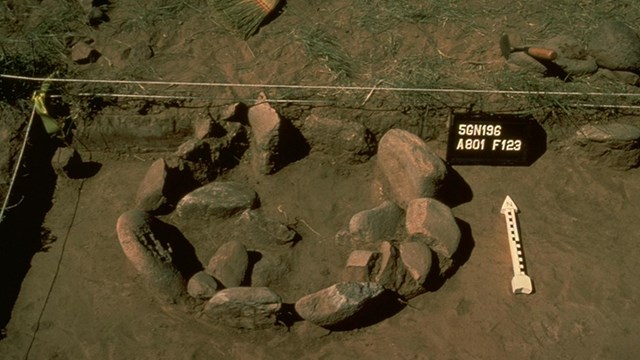|
Human occupation of this area dates back to at least 10,000 years ago. Archeologists have uncovered evidence of prehistoric hunting and gathering camps around present day Curecanti. Peoples from traditionally associated tribes moved seasonally between the mountains and present day Montrose and Grand Junction. They were attracted here by the abundance of game in the dry hills and river valleys, and by the vegetation in the canyons and on the mesas. Fur traders and miners blazed the northern branch of the Old Spanish Trail from Santa Fe to Los Angeles. This trail first linked the Utes to Anglo and Spanish commerce. As mining operations sprung up in the mountains of Gunnison County, homesteaders built farms and ranches along the Gunnison River. Ranching remains part of the county's livelihood today. Captain John W. Gunnison and his Pacific Railroad party, who surveyed the area in 1853, discouraged building a railroad due to difficult terrain. Despite this and other expeditions reports, a narrow-gauge railroad was built and transported ore, coal, cattle and other goods through the Curecanti area by 1882. Passengers also took a scenic ride on the Denver & Rio Grande Western Railroad, bearing the Curecanti Needle on its logo. The railroad spurred development of small towns such as Iola, Cebolla, Sapinero and Cimarron. The railroad operated from 1882 to 1949. Small communities continued to thrive even after its heyday. People were drawn to the hunting and fishing opportunities and stayed at hotels. The region's farmers and ranchers soon coveted the Gunnison River's waters for their crops and livestock. The Gunnison Tunnel, a six mile long irrigation tunnel, was cut through a mesa to deliver water to the Uncompagre Valley. In 1965, Blue Mesa Dam was completed as part of the Wayne N. Aspinall Storage Unit. Morrow Point and Crystal dams followed in 1967 and 1976. The dams and subsequent reservoirs were created primarily to provide water storage to the Upper Colorado River Basin states of Colorado, Wyoming, New Mexico and Utah. Curecanti National Recreation Area was established in 1965 to manage the land on and around the Aspinall Unit. 
Places
The railroad linked Gunnison to the Uncompahgre Valley. Communities thrived along the river. Late, the reservoirs changed that landscape. 
Earliest Humans
Physical evidence of human occupation in present-day Colorado dates back thousands of years. 
Traditionally Associated Tribes
Four federally recognized tribes and one tribal community have cultural ties to the area within and surrounding the recreation area. 
Explorers
Expeditions came to the area in search of railroad passageways, mineral wealth, and water. 
Archeology
For at least the last 10,000 years humans have been passing through what is now Curecanti National Recreation Area. 
Collections
Learn about the Cimarron Rail Exhibit and train restoration project. |
Last updated: April 28, 2025
